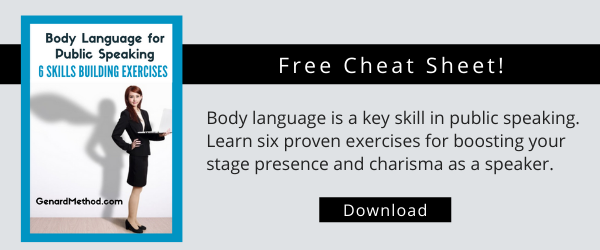What does your body language reveal about you when you speak in public? More than you think!
(Download my free cheat sheet, "5 Secrets of Powerful Body Language" to learn the key areas you need to understand to use body language effectively.)
In terms of what you show through body language, it's something of a good news/bad news situation: You may be revealing something you'd rather your audience didn't know. Or you could be using nonverbal communication productively to aid your impact and influence with listeners.
Why not align your use of body language with the latter scenario?
Stance and Movement Tell Your Audience How You Feel
I thought of body language and what it reveals last night, watching Bruce Dern's excellent performance in the film "Nebraska." When I was acting professionally, one of the first tasks I always attended to in creating a character was to get the person's walk right. In other words, if I understood how that person walked, I knew I'd gain an important insight on how that character viewed and responded to the world.
In "Nebraska," a key to Mr. Dern's creation of Woody Grant is his distinctive shuffling, world-weary, stubborn and determined walk. Whenever this actor decided on Woody's style of walking —early or late in the creation of the character—I'm convinced it was a key decision that gave him an essential tool for communicating the essence of this man to the audience.
In your public speaking and presentations, be aware that the same equation applies concerning how you look at the world. To move an audience, you need to do more than deliver information. You must also invite listeners to share your vision, and to let them know that you enjoy the opportunity to open your world to them, at the same time you welcome connecting with their needs. The way you stand, move, and relate to the audience in physical terms either makes this connection work, or misses the mark.
How specifically do you do this? Use good posture, and move with purpose rather than wandering. Employ inclusive gestures that literally reach out to your listeners. And take every opportunity to reduce the distance between you and your audience, letting them know you truly want to be close to them.
Your Gestures Should Amplify Meaning
Another way to use body language effectively as a speaker is simply to understand that your body is an important tool of communication. We are not brains encased in bell jars, sending thoughts to each other telepathically.
Audiences watch what we show them when we speak in person, in teleconferences, via Skype, or in videos—and how could it be otherwise? The answer to the common question, "What do I do with my hands?" is simply this: use them to support what you're saying at that moment, and to amplify meaning. Make your gestures few in number, clean, and well defined—and always in support of something important that you're saying. Listeners will more than likely retain that key part of your message.
The Subtle Signals You Send
When you use body language as a tool that supports both your relationship with your audience and the meaning of what you're saying to them, you'll be able to tap into the more subtle benefits of nonverbal communication. Stance, facial expressions, and gestures are applications of effective body language that are easy to understand.
More subtle are the ways you can use space, proximity to your listeners, and objects to enrich your relationship with your listeners and your material. That's the subject of my next blog.



